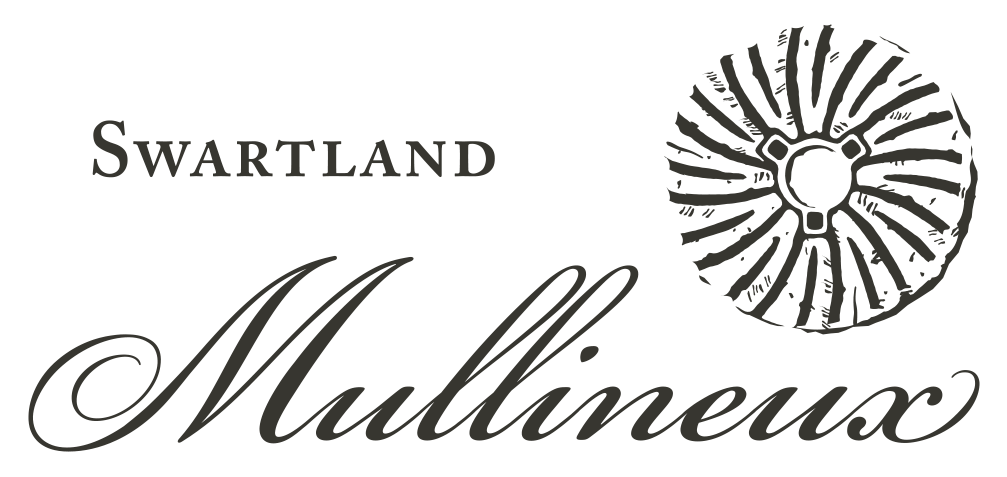Mullineux Signature, Old Vines Swartland White Blend


Vintage: 2023
| Vintage | Product Code | Format | Closure | Availability |
|---|---|---|---|---|
| 2023 | MU103B23 | 6 x 75 | Natural Cork | Available |
Producer
Founded by Chris and Andrea Mullineux in 2007, Mullineux is one of the most lauded wineries in South Africa, having been named ‘Winery of the Year’ five times by the Platter Guide (in 2014, 2016, 2019, 2020 and 2023). Chris and Andrea chose the town of Riebeek-Kasteel, just west of Malmesbury in the Swartland, due to its old vineyards planted on granite and schist soils. They reasoned that, with such quality fruit, they could make outstanding wines. It is an understatement to say they have been proved right.
The Swartland is warm and dry in the summer, benefitting from a cooling afternoon breeze from the Atlantic Ocean, which borders the region to the West. Disease pressure is low, which, in turn, means spraying is kept to a minimum. The fashion for monoculture in the 1970s and 1980s bypassed the Swartland. As a result, most of the vineyards that Chris and Andrea own, or lease are planted with numerous native species like fynbos. These provide a home for native insects, which act as predators of other insects that can damage the vines. Again, this enables spraying to be kept to a minimum.
The Mullineux Range boasts a Syrah, an ‘Old Vines’ White and a ‘Straw Wine’. The Syrah blends fruit from schist, iron and granite soils across a range of Swartland vineyards. 90% of the fruit is whole bunch fermented, with maceration extended to as long as seven weeks for some batches simply because of the quality of the tannins. This creates a lovely structure and balance to the wine, with the tannins corseting ripe and voluptuous fruit. The wine is aged in oak, 15% of which is new, for 14 months before bottling. The ‘Old Vines’ White is sourced from seven low-yielding (4-6 tonnes per hectare) vineyards in the Swartland. It is predominantly Chenin Blanc, blended with a touch of Semillon Gris, Clairette Blanche, Grenache Blanc, Viognier, and Verdelho. The winemaking is similar to the Single Terroir Chenins, using whole bunch pressing and fermentation in barrel with 100% malolactic. The resulting wine is aged for 11 months in a combination of old French oak 500-litre barrels and 2,000-litre foudre. Their ‘Straw Wine’ is made from old vine Chenin Blanc harvested at normal ripeness levels and air-dried for three to four weeks, concentrating the sugars, flavours and, most importantly, acidity. The wine is slowly pressed and fermented in old barrels for six to nine months, before natural settling and bottling. The resulting wine has an intense nose of dried fruit, marmalade, marzipan and honey. On the palate, it is powerful and complex, with around 300 grams per litre of residual sugar balanced by a vibrant acidity, leaving the wine tasting fresh and dry. Mullineux’s ‘Olerasay’ Straw Wine is undoubtedly one of the world's great sweet wines and incredibly rare. Produced from barrels which have been fractionally blended for the vintages 2008 through to 2022, it has layers of complexity, nuttiness and depth.
Vineyards
The 2023 Old Vines White is a blend of eight sustainably farmed parcels that are up to 68 years old from across the Swartland. Four, composed of Chenin Blanc, Verdelho, Clarette Blanche and Grenache Blanc, are planted on the schist-based soils of the Kasteelberg. These stony soil lend structure to the blend. Two parcels of 40-65-year-old, dry land, bush vine Chenin Blanc, one parcel of Viogner and a 60-year-old heritage Semillon Gris vineyard are grown on the decomposed granite soils of the Paardeberg. The age of the vines, and the granite content in the soil, results in concentrated, complex wines with vibrant acidity. The final parcel of Chenin Blanc, grown on the iron-rich soils of the rolling hills west of Malmesbury, provides lifted acidity and rich texture.
Vintage
The 2023 vintage saw some heatwaves throughout the growing season, but cool evenings and very little precipitation assisted in maintaining the vine health despite the heat. Cool weather near harvest allowed for a slow and gradual ripening period which developed beautifully concentrated berries.
Vinification
The grapes were harvested by hand and left to chill in Mullineux's cold room facility. The grapes were then pressed as whole bunches and the juice was allowed to settle overnight. Minimal SO2 was added and, as with all their wines, no other additions were made. The juice was then racked to barrel for fermentation. Fermentation took place with indigenous yeasts and lasted up to ten weeks. The wine was left without additional sulphur on its lees until spring, with 11 months spent in third and fifth fill French oak 500L barrels and one new 2000L Foudre. During this time the wine finished malolactic fermentation. The barrels were racked and blended just before the following vintage and bottled unfiltered.
Tasting Notes & Technical Details
This wine has lifted aromas of fresh peach, poached pears, orange blossom and dried honey. The palate is fresh, and richly textured, with notes of almond, yellow grapefruit and ginger, which follow through to a long and layered finish.
Alcohol (ABV)
14%
Acidity
5.6 g/l
Residual Sugar
2 g/l
pH
3.37
Other wines from this producer
Producer | Wine | Product Code | Features | Style | |
|---|---|---|---|---|---|
| Signature | Swartland Syrah | MU104 | R | Factsheet | |
| Signature Straw Wine | MU105 | Sw | Factsheet | ||
| Olerasay 3º Straw Wine Chenin Blanc | MU117 | Sw | |||
| Single Terroir | `Granite` Swartland Chenin Blanc | MU106 | W | Factsheet | |
| `Granite` Swartland Syrah | MU108 | R | Factsheet | ||
| `Schist` Swartland Syrah | MU109 | R | |||
| `Iron` Swartland Syrah | MU110 | R | Factsheet | ||
| `Schist` Swartland Chenin Blanc | MU115 | W | Factsheet |